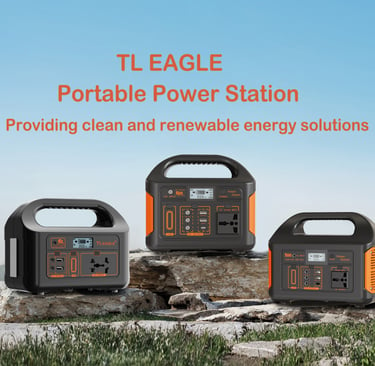What is the role of portable power station inverter
11/4/20252 min read


The inverter is a core component in portable power station. Its core function is to convert the direct current (DC) stored in the battery into alternating current (AC), enabling the portable power station to power most devices that rely on AC power. The following is a detailed explanation of its specific functions and importance:
I. Core Function: DC to AC (DC→AC)
Solving the Fundamental Conflict
Energy storage batteries (such as lithium batteries) store DC power, but over 90% of everyday electronic devices (such as fans, refrigerators, and laptop chargers) require AC power to operate.
The inverter performs this critical conversion through electronic circuits, making the energy storage power supply practical.
Mimulating the Mains Waveform
High-quality inverters output pure sine wave AC (same waveform as the mains power source at home outlets), making them compatible with sensitive equipment (such as medical devices and precision instruments). Lower-cost inverters may output a rectified or square wave, making them suitable only for resistive loads (such as electric blankets).
II. Key Additional Features
✅ Voltage Regulation and Stabilization
Automatically matches voltage requirements (e.g., 110V/220V) based on device requirements and stabilizes output voltage fluctuations within a ±5% range to prevent device damage due to voltage instability.
✅ Simultaneous Power Supply for Multiple Devices
Equipped with multiple AC outlets, USB-A/C ports, and a car cigarette lighter port, it can simultaneously power mobile phones, computers, small appliances (such as mini refrigerators), photographic equipment, and more.
✅ Intelligent Management and Protection
Overload Protection: Automatically cuts off output when the power of the connected device exceeds the rated value to prevent circuit burnout.
Short-Circuit Protection: Instantly cuts off current to prevent fire risks.
Temperature Control: Built-in cooling fan or temperature control chip prevents performance degradation or safety hazards caused by high temperatures.
Low Voltage Shutdown: Automatically shuts off output when the battery is low to preserve battery life.
✅ Improved Energy Efficiency
The high-efficiency inverter (with a conversion rate of over 90%) reduces power loss and extends battery life on a single charge. Some high-end models support "bypass mode," drawing power directly from the mains when the grid is normal, switching to battery-inverter mode only during power outages, further improving efficiency.
III. Considerations for Inverter Selection
Power Matching
The maximum inverter power must be greater than or equal to the total power of the connected devices (e.g., if the total power of the devices is 800W, select an inverter with a power rating of 1000W or higher).
Pay attention to the "peak power" parameter; the power consumption of some devices (such as air conditioner compressors) can reach 2-3 times the rated power when they start up. Waveform Quality
For sensitive devices, always choose a pure sine wave inverter (marked "Pure Sine Wave").
For general appliances, a modified sine wave inverter can reduce costs.
Certification Standards
International brands must obtain UL, CE, FCC, and other certifications to ensure safety and compatibility.
Inverters for vehicles must comply with ISO/TS16949 automotive-grade standards.
Summary
The inverter is the heart of a portable energy storage power supply. Without it, the energy stored in the battery cannot be used by conventional devices. When selecting an inverter, consider power, waveform quality, protection features, and usage scenarios to ensure it meets power needs safely and efficiently.
